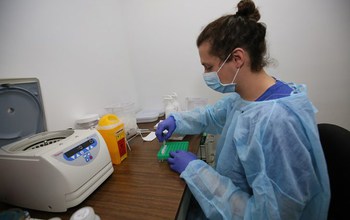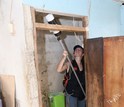News Release 16-018
Seeking Zika: Where and when will Zika-carrying mosquitoes strike next?
NSF-funded scientists look for answers in coastal Ecuador

Scientists are studying transmission of the Zika virus in three towns in Ecuador.
February 18, 2016
This material is available primarily for archival purposes. Telephone numbers or other contact information may be out of date; please see current contact information at media contacts.
Find related stories on the NSF, National Institutes of Health and U.S. Department of Agriculture's Ecology and Evolution of Infectious Diseases (EEID) program at this link.
Zika: The virus has emerged as a major public health threat that's rapidly spreading through South and Central America and the Caribbean.
Usually a relatively mild illness, Zika may be linked with birth defects such as microcephaly, and with the neurological disorder Guillain-Barre Syndrome.
Where and when will Zika strike next? Scientists funded by the National Science Foundation (NSF) Ecology and Evolution of Infectious Diseases (EEID) program are looking for answers in three places in Ecuador. NSF's EEID program is a joint effort with the National Institutes of Health and the U.S. Department of Agriculture.
Mosquito bites
Zika is transmitted by Aedes aegypti mosquitoes -- the same mosquitoes that carry dengue and chikungunya viruses, and that were historically responsible for yellow fever.
Since 2007, 39 countries have reported cases of Zika, according to the World Health Organization.
A few days after a female Aedes aegypti mosquito bites a virus-infected person, the mosquito can develop its own infection, which it then transmits to the next person it bites, says Erin Mordecai, an ecologist and infectious disease specialist at Stanford University. Only female Aedes aegypti mosquitoes bite humans; males feed on nectar.
Aedes aegypti, found in tropical and sub-tropical areas, often breeds in small pools of water near human houses and other developments. Buckets, flower pots and used tires are favorite sites.
Unlike other mosquitoes that bite people only in the evening, Aedes aegypti bites throughout the day, increasing exposure to viruses like Zika.
Seeking Zika
A group led by Mordecai is studying the socio-ecology and climate responses of dengue and Zika virus transmission by catching Aedes aegypti mosquitoes at three sites in southern coastal Ecuador.
"The research has the potential to provide basic knowledge that will help control all mosquito-borne pathogens, while also being extremely timely," says Sam Scheiner, NSF EEID program director. "Diseases like Zika virus are likely to continue. This project will help us find ways to get a handle on future such outbreaks."
Mordecai's work builds on a long-term collaboration, led by scientist Anna Stewart of the State University of New York (SUNY) Upstate Medical University, with the Ecuador Ministry of Health and Ecuador National Institute of Meteorology and Hydrology.
Ecuador is one of 26 countries in the Americas that has reported active Zika virus transmission, according to the U.S. Centers for Disease Control and Prevention.
The Ecuador towns where the EEID researchers are working -- Machala, Huaquillas, and Portovuelo/Zaruma -- vary in climate, elevation and socioeconomic conditions, and in their amount of mosquito-borne disease.
In recent studies, Machala had the highest abundance of Aedes aegypti larvae of all sites surveyed in 10 countries in Latin America and Asia, indicating high risk for virus transmission.
The scientists are counting mosquitoes by using vacuums mounted on backpacks to collect adult mosquitoes, and by setting egg traps designed to mimic the small containers of water that are Aedes aegypti's natural egg-laying habitat. The team is also identifying the viruses the mosquitoes carry.
By collecting weather and social data, the group hopes to discover the socioeconomic and environmental factors that put people most at risk for diseases carried by Aedes aegypti.
The research is focused on environmental factors such as temperature and humidity that may affect human mosquito exposure, and social factors such as housing type, household size and wealth.
Ultimately, the biologists hope to halt viruses the mosquitoes transmit by learning what environmental conditions promote dengue and Zika, in particular.
The risk landscape
Studying interacting factors allows researchers to understand the "risk landscape" for Aedes-transmitted diseases, according to Sadie Ryan, an ecologist and medical geographer at the University of Florida who is collaborating on the research.
Taking a local approach then broadening it, the scientists believe, will allow them to find out when and where interventions -- such as in vector control, healthcare infrastructure, environmental modification, education, and climate change early warning systems -- may be most effective.
In addition to surveying mosquitoes and viruses in the field, the biologists are developing mathematical models to discover how disease transmission by Aedes aegypti responds to temperature, important for predicting future changes in virus transmission under climate change, says Mordecai.
"Mosquitoes are tiny and cold-blooded, so their growth, development, and survival depends upon the temperature around them," she says. "Disease transmission is a complex process. It's important to understand how mosquitoes and the viruses they carry respond to temperature, to know when and where virus transmission will increase as Earth warms."
-NSF-
-
An Aedes aegypti mosquito, carrier of the Zika virus in South and Central America.
Credit and Larger Version -
Zika-carrying mosquitoes often breed in small pools of water in buckets, flower pots and the like.
Credit and Larger Version -
Biologists working in Ecuador are catching mosquitoes to identify the viruses they carry.
Credit and Larger Version -
Vacuums mounted on backpacks help scientists trap mosquitoes for further study.
Credit and Larger Version -
Infectious disease researchers hope to halt viruses such as Zika by studying environmental factors.
Credit and Larger Version
Media Contacts
Cheryl Dybas, NSF, (703) 292-7734, email: cdybas@nsf.gov
Related Websites
NSF News: National Science Foundation issues call for Zika virus proposals: http://www.nsf.gov/news/news_summ.jsp?cntn_id=137621&org=NSF
NSF Special Report: Ecology and Evolution of Infectious Diseases: http://www.nsf.gov/news/special_reports/ecoinf/
NSF News: To slow the spread of infectious diseases, NSF, NIH, USDA support new research: https://www.nsf.gov/news/news_summ.jsp?cntn_id=136044
NSF EEID Discovery Article Series: http://www.nsf.gov/discoveries/disc_summ.jsp?cntn_id=137557
NSF Grant: Effects of temperature on vector-borne disease transmission: integrating theory with empirical data: http://www.nsf.gov/awardsearch/showAward?AWD_ID=1518681&HistoricalAwards=false
The U.S. National Science Foundation propels the nation forward by advancing fundamental research in all fields of science and engineering. NSF supports research and people by providing facilities, instruments and funding to support their ingenuity and sustain the U.S. as a global leader in research and innovation. With a fiscal year 2023 budget of $9.5 billion, NSF funds reach all 50 states through grants to nearly 2,000 colleges, universities and institutions. Each year, NSF receives more than 40,000 competitive proposals and makes about 11,000 new awards. Those awards include support for cooperative research with industry, Arctic and Antarctic research and operations, and U.S. participation in international scientific efforts.
Connect with us online
NSF website: nsf.gov
NSF News: nsf.gov/news
For News Media: nsf.gov/news/newsroom
Statistics: nsf.gov/statistics/
Awards database: nsf.gov/awardsearch/
Follow us on social
Twitter: twitter.com/NSF
Facebook: facebook.com/US.NSF
Instagram: instagram.com/nsfgov







